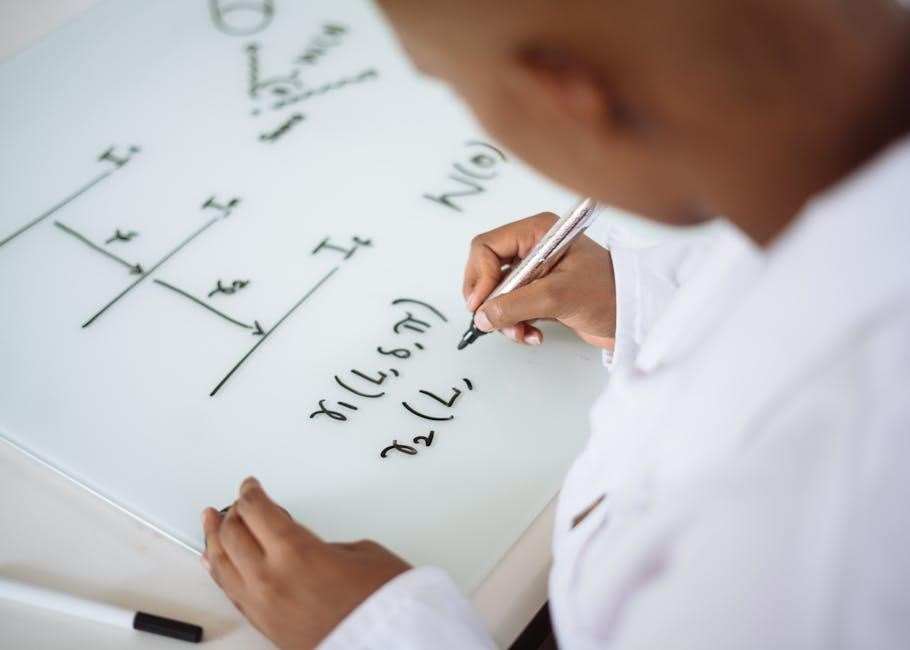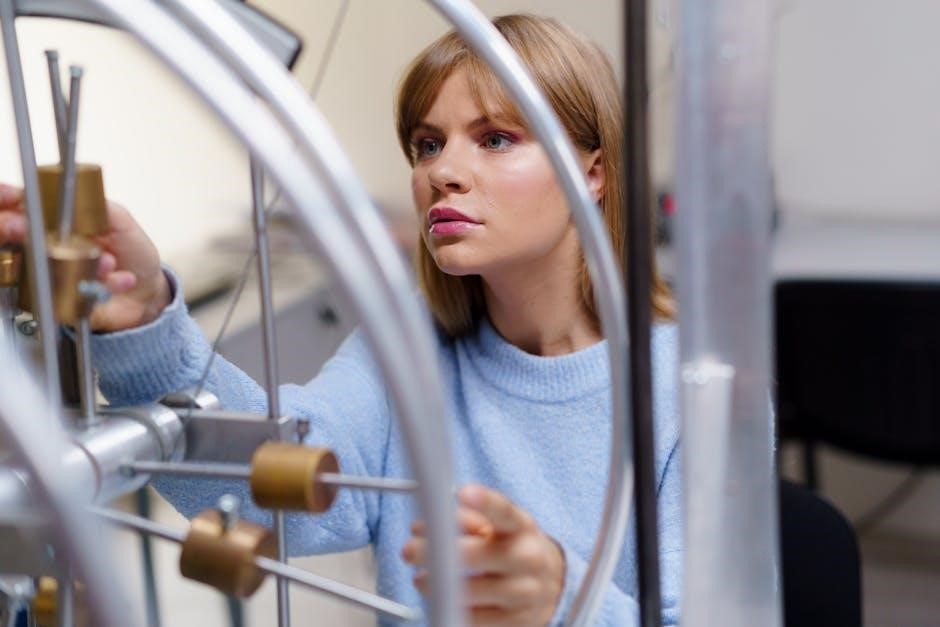Welcome to the Physics Lab Manual, a comprehensive guide for practical learning. This manual provides structured experiments, safety protocols, and data analysis techniques, aligning with educational standards for an enhanced learning experience.
1.1 Purpose and Scope of the Manual
This manual serves as a guide for students and educators, detailing practical experiments and procedures to enhance physics understanding. Its scope includes foundational concepts, advanced techniques, and essential skills like data analysis and error handling. Designed to align with curriculum standards, it supports hands-on learning, fostering critical thinking and problem-solving abilities through structured laboratory activities and investigations.
1.2 Importance of Practical Work in Physics
Practical work in physics is essential for reinforcing theoretical concepts and developing manipulative, observational, and reporting skills. It bridges the gap between theory and real-world applications, encouraging critical thinking and problem-solving. Hands-on experiments make learning interactive and engaging, helping students internalize complex ideas. Additionally, practical work builds confidence in using laboratory equipment and conducting experiments, which are crucial skills for scientific research and education.
Safety Guidelines and Precautions
Safety is crucial in physics labs to protect students and equipment. This section outlines essential precautions, proper handling of equipment, and use of protective gear, emphasizing adherence to protocols to prevent hazards and ensure well-being.
2.1 General Laboratory Safety
General laboratory safety ensures a secure environment for experiments. Wear protective gear like goggles and gloves, avoid loose clothing or jewelry, and keep long hair tied back. Familiarize yourself with emergency equipment, such as fire extinguishers and eyewash stations. Never work alone or bypass safety protocols. Handle equipment with care, and avoid tasting or smelling substances. Always follow instructions carefully to prevent accidents and ensure a safe learning experience for everyone.
2.2 Handling Hazardous Materials and Equipment
When handling hazardous materials and equipment, always wear appropriate PPE, such as gloves and goggles; Ensure proper ventilation and avoid direct contact with chemicals. Follow safety data sheets (SDS) for handling, storage, and disposal. Use equipment only as instructed, and ensure it is calibrated and maintained. Regularly inspect equipment for damage, and report any issues immediately. Properly label and store hazardous substances to prevent accidents and contamination.
Common Physics Lab Experiments
This section introduces fundamental physics experiments, such as the Sonometer and Carey Foster’s Bridge. These exercises help students explore key concepts like wave motion and electrical resistance through practical observation and measurement.
3.1 Experiment 1: Sonometer
The Sonometer experiment investigates wave patterns and frequency relationships. By stretching strings of varying lengths and tensions, students observe transverse waves and measure harmonics. This setup demonstrates fundamental acoustic principles, linking theoretical concepts to practical observations, enhancing understanding of wave physics and resonance phenomena through hands-on exploration and data analysis.
3.2 Experiment 2: Carey Foster’s Bridge
The Carey Foster’s Bridge experiment measures unknown resistances using a Wheatstone bridge principle. It employs a null deflection method for high accuracy. Students set up the bridge, balance it, and calculate the unknown resistance. This experiment enhances understanding of electrical circuits and resistance measurement techniques. It also emphasizes the importance of precise measurements and safe handling of laboratory equipment.

Data Analysis and Error Handling
This section covers techniques for accurate data analysis, understanding errors, and effective graphing to enhance the reliability of experimental results in physics labs.
4.1 Understanding Error Analysis
Understanding error analysis is crucial in physics labs to ensure accurate results. It involves identifying random and systematic errors, quantifying uncertainties, and improving measurement precision. By analyzing errors, students learn to evaluate data reliability and refine experimental techniques, fostering a deeper understanding of scientific rigor and problem-solving in practical physics investigations.
4.2 Graphing Techniques for Lab Results
Graphing techniques are essential for visualizing and interpreting lab data. Properly plotting results helps identify trends, relationships, and deviations. Using tools like line graphs or bar charts, students can present findings clearly. Best practices include clear labeling, consistent scales, and concise titles to ensure readability and accuracy, enhancing the understanding of experimental outcomes in physics investigations.

Essential Laboratory Equipment
Essential lab equipment includes multimeters, oscilloscopes, signal generators, and sensors. These tools enable precise measurements and data collection, fostering hands-on exploration of physics principles and phenomena effectively.
5.1 List of Common Physics Lab Equipment
The physics lab is equipped with essential tools for experiments, including multimeters for voltage and current measurements, oscilloscopes for waveform analysis, signal generators, and sensors for data collection. Other common items are stopwatches, thermometers, spring balances, and optical benches for precise setups. These instruments enable accurate observations and calculations, making them indispensable for practical physics exploration and learning.
5.2 Maintenance and Calibration of Instruments
Regular maintenance and calibration of physics lab instruments are crucial for accurate results. Instruments should be inspected, cleaned, and stored properly to prevent damage. Calibration ensures measurements are precise, using standard references or manufacturer guidelines. Trained personnel typically handle calibration, while routine checks can be performed by students. Proper repair and replacement of worn parts maintain functionality. This care ensures reliability and safety in experiments.

Projects and Investigations
Projects and investigations in physics labs encourage deep exploration of concepts, fostering innovation and practical application. These activities align with curriculum standards, promoting critical thinking and problem-solving skills.
6.1 Advanced Projects in Physics
Advanced projects in physics labs involve complex investigations, such as quantum mechanics experiments or renewable energy applications. These projects integrate theoretical concepts with experimental techniques, fostering innovation and critical thinking. Students design and execute experiments, analyze data, and draw meaningful conclusions. Such projects prepare learners for real-world scientific challenges, enhancing their problem-solving and research skills. They align with curriculum standards, promoting deeper understanding and practical application of physics principles.
6.2 Group Investigations and Collaborative Learning
Group investigations and collaborative learning are essential in physics labs, fostering teamwork and communication. Students work together on experiments, sharing ideas and تقسیم responsibilities. This approach enhances problem-solving skills, data interpretation, and scientific understanding. Collaborative projects align with curriculum standards, promoting active learning and preparing students for real-world challenges in science and technology.

Demonstrations and Lecture Experiments
Demonstrations and lecture experiments are key tools for illustrating complex physics concepts. They engage students, enhance understanding, and provide practical insights into theoretical principles, fostering deeper learning and curiosity.
7.1 Demonstrations for Key Physics Concepts
Demonstrations for key physics concepts are designed to make abstract ideas tangible. They use hands-on activities and visual setups to illustrate principles like motion, forces, and electromagnetism. These engaging displays help students grasp complex theories, fostering curiosity and a deeper understanding of scientific phenomena. Practical demonstrations also encourage collaborative learning and critical thinking among students.
7.2 Lecture Experiments for Enhanced Learning
Lecture experiments integrate hands-on activities with theoretical instruction, enhancing student engagement. These experiments are concise, designed to demonstrate key concepts during lectures. They often involve interactive setups, such as data collection tools, to illustrate principles like motion, thermodynamics, or electromagnetism. By combining visual and practical elements, lecture experiments bridge theory and practice, fostering a deeper understanding and encouraging active participation in the learning process.
Additional Resources and References
This section provides a list of recommended textbooks, online tools, and software to support physics lab work. Resources include NGSS-aligned materials and lab manuals like PASCO’s.
8.1 Recommended Lab Manuals and Textbooks
Essential resources include PASCO’s Essential Physics Teacher Lab Manual and Physics Explorations and Projects, aligned with NGSS. Textbooks like Experiments in Modern Physics Lab and General Physics Lab Experiments are highly recommended. These manuals offer comprehensive guides for experiments, activities, and projects, covering topics from classical mechanics to modern physics. They provide detailed procedures, safety tips, and analysis techniques for effective learning.
8.2 Digital Tools and Software for Physics Labs
Digital tools like Vernier’s Logger Pro and PASCO’s SPARKvue enhance lab experiences through real-time data collection and analysis. Simulation software, such as PhET, offers interactive models for complex concepts. Online platforms provide virtual labs, enabling remote learning. These tools integrate with lab manuals, offering step-by-step guides and data visualization, aligning with educational standards for a modern, interactive learning environment.
Alignment with Curriculum Standards
This manual aligns with NGSS and university standards, ensuring comprehensive coverage of physics concepts. Experiments and activities are designed to meet learning objectives, fostering deeper understanding and practical skills.
9.1 NGSS and Physics Lab Experiments
The manual aligns with the Next Generation Science Standards (NGSS), ensuring experiments are designed to meet learning objectives. Activities emphasize hands-on engagement, encouraging critical thinking and problem-solving. Experiments cover essential physics concepts, preparing students for assessments and fostering scientific literacy. This alignment ensures students gain a deep understanding of key principles, making the manual a valuable resource for NGSS-based education.
9.2 University and High School Physics Standards
This manual meets both university and high school physics standards, offering experiments aligned with curriculum requirements. It covers classical mechanics, optics, and electronics, ensuring comprehensive learning. The content is structured for diverse skill levels, from introductory concepts to advanced topics, making it suitable for students transitioning from high school to university. Experiments are balanced to meet the needs of both groups effectively.
Reporting and Documentation
This section emphasizes the importance of accurate documentation and clear reporting in physics labs. It provides guidelines for writing detailed lab reports, analyzing data, and using software tools to enhance documentation quality.
10.1 Writing Lab Reports
Writing lab reports is a critical skill in physics education, requiring clear and concise communication of experiments, data, and conclusions. Proper formatting, accuracy, and attention to detail are essential. Reports should include objectives, methods, results, and discussions. Visual aids like graphs and tables enhance understanding. Students should review and edit their work to ensure clarity and correctness, adhering to academic standards for scientific documentation.
10.2 Documenting Observations and Results
Accurate documentation of observations and results is vital in physics labs. Record data systematically, using tables, graphs, and descriptive notes. Ensure measurements are precise and uncertainties noted. Raw data should be preserved, and calculations clearly shown. This structured approach aids in analysis, supports conclusions, and ensures reproducibility of experiments, fostering transparency and rigor in scientific inquiry and reporting.
The physics lab manual serves as a comprehensive guide, fostering practical skills, critical thinking, and a deeper understanding of physics concepts through structured experiments and documentation.
11.1 Summary of Key Concepts
The physics lab manual emphasizes hands-on learning, safety protocols, and data analysis. It covers essential experiments, error handling, and reporting techniques, fostering a deep understanding of physics principles. Practical skills, collaborative learning, and alignment with curriculum standards are highlighted to prepare students for advanced investigations and real-world applications in physics.
11.2 Encouragement for Further Exploration
Encourage students to delve into advanced physics concepts through innovative projects and investigations. Leverage digital tools and resources for enhanced learning experiences. Engage in collaborative environments and competitions to refine problem-solving skills. Cultivate curiosity and passion for physics to drive future innovations and discoveries, ensuring continuous growth in scientific exploration.